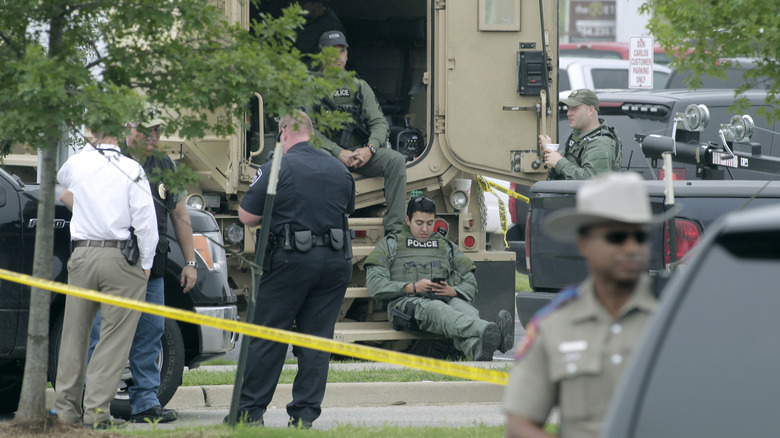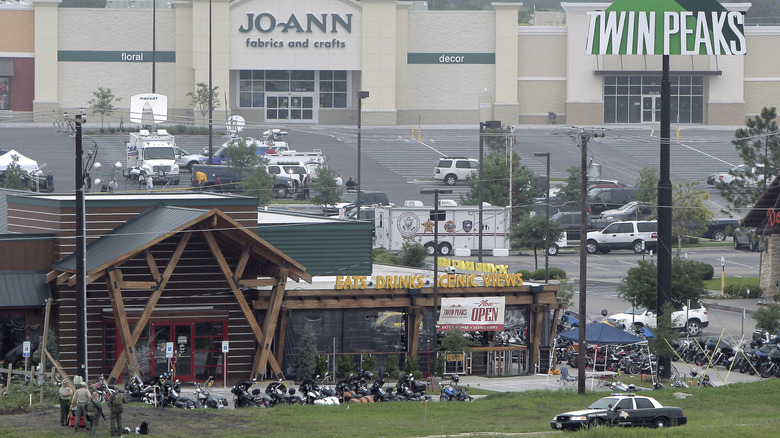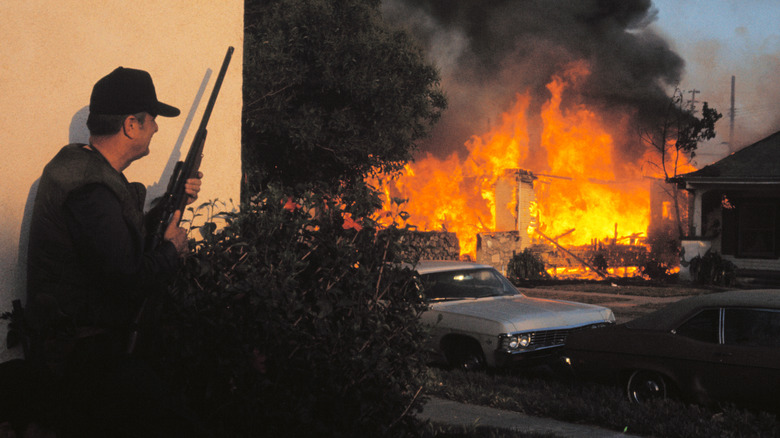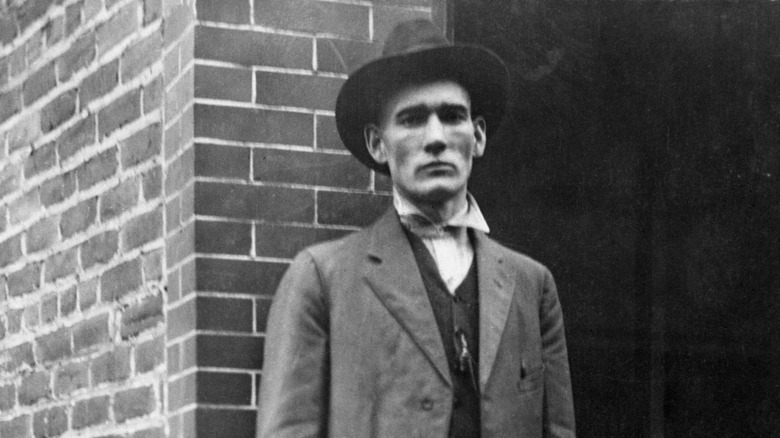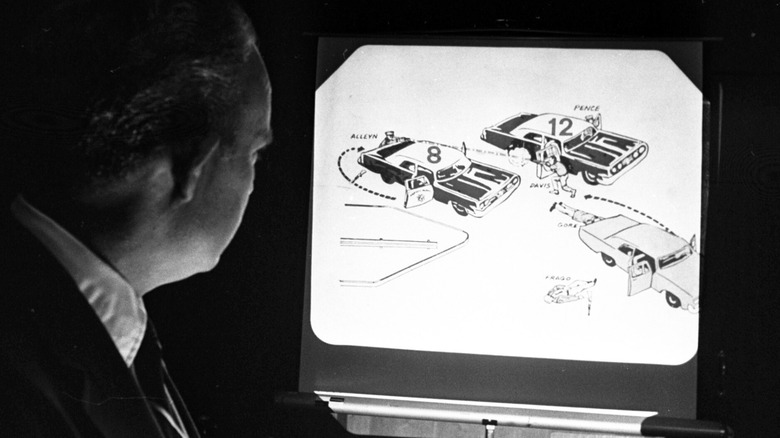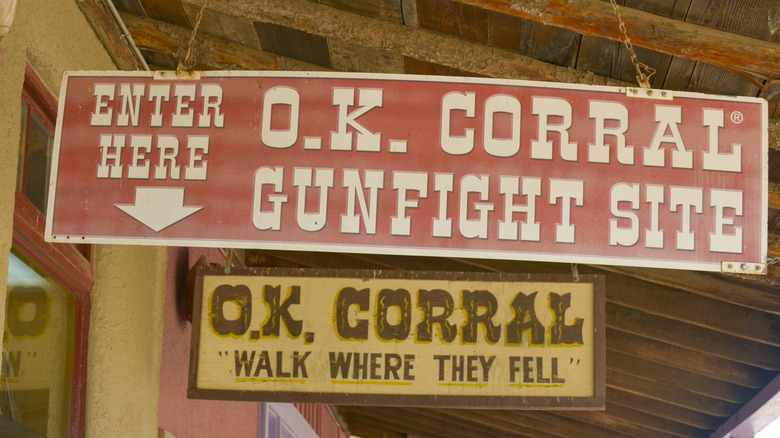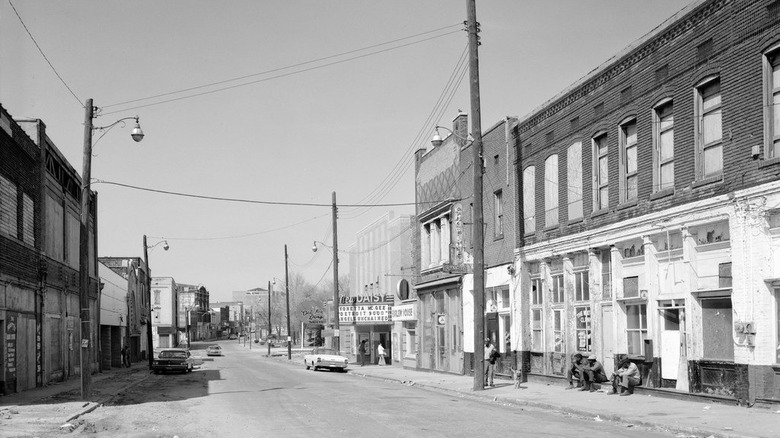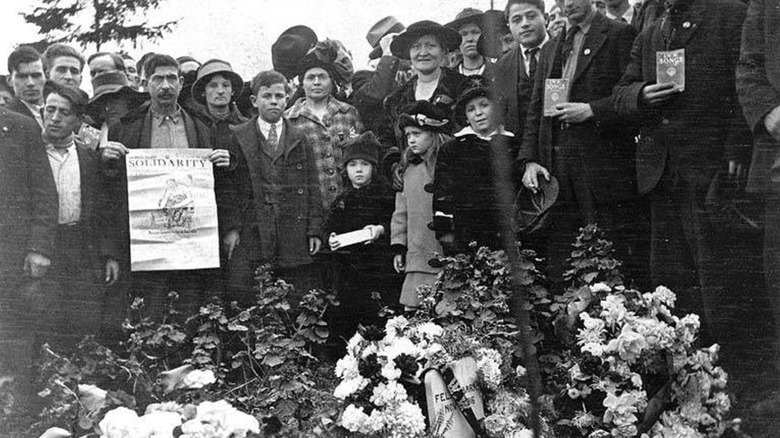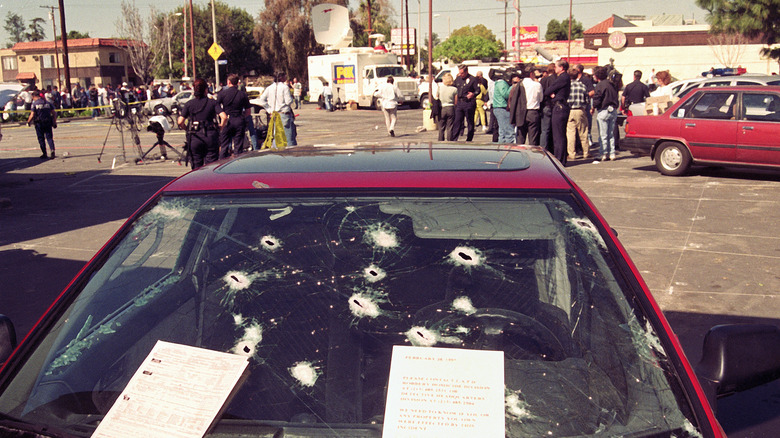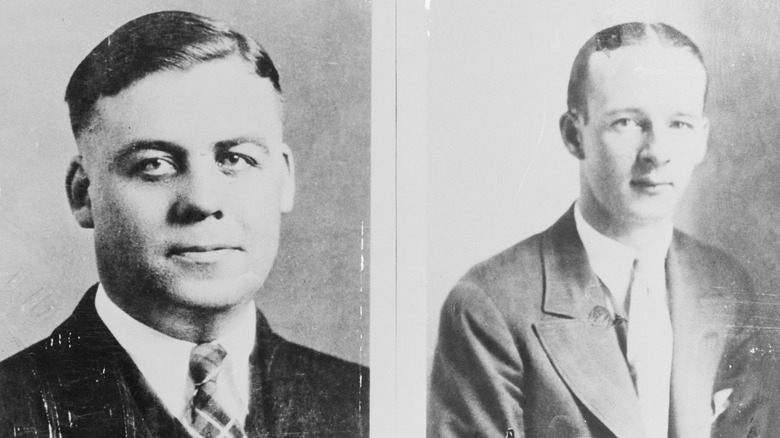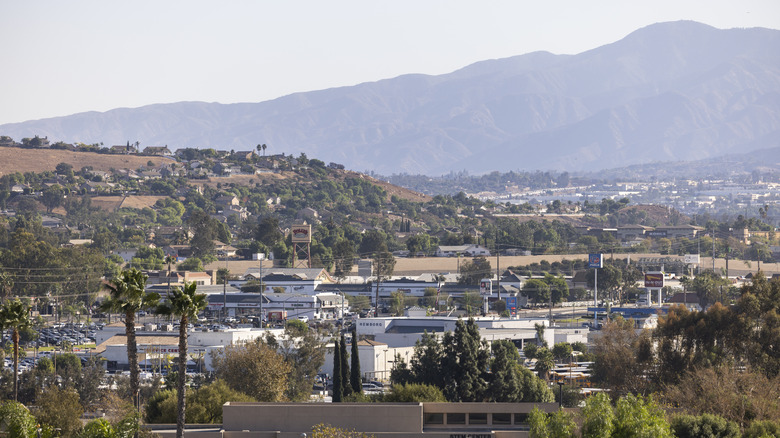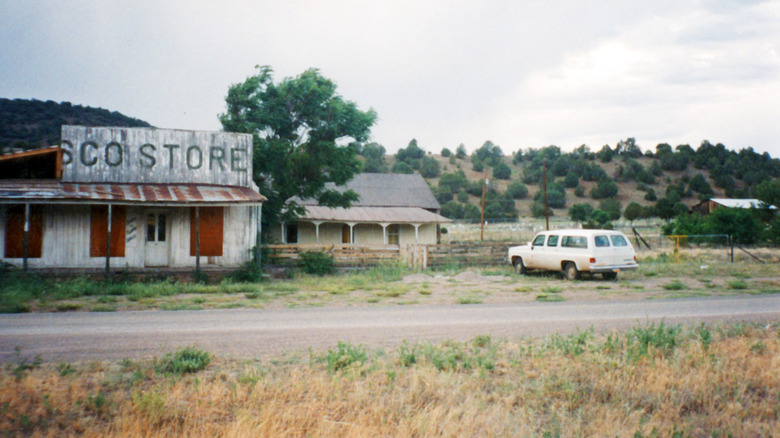The Wildest Shootouts In American History
While shootings are sadly all too common in modern America, less common are shootouts: Decisive gun battles between two sides, outside the context of war. Sometimes these occur between criminals and law enforcement, other times between civilians who have beef with each other that descends into violence. And innocent bystanders are often caught in the crossfire.
While everyone has heard the truth about Wild West gunfights, those were often relatively tame compared to more modern shootouts. The firepower available to the average person is so much greater now, and over the years, law enforcement agencies have been increasingly militarized. These days, shootouts occur between adversaries armed with weapons that Wild West outlaws couldn't possibly conceive of. However, it's not just the number of lives tragically lost that makes a shootout notably crazy — it's all about the details and how the situation plays out. With that in mind, here are some of the wildest shootouts in American history.
The 2015 Waco biker shootout
After months of evidence indicating the growing conflict between two rival biker gangs, things erupted in violence on May 17, 2015, in Waco, Texas, in the parking lot of a Twin Peaks restaurant. While members of the Bandidos OMG and the Cossacks MC motorcycle gangs were the main combatants in the bloody shootout, a total of five biker gangs took part (not the one you might expect: The Hells Angels were not connected to the Waco shootout). Even with the gangs' proud embrace of lawlessness, this violence was "bolder, more in-our-face" than usual, as Randy McBee, an academic who studies biker culture, explained to the Los Angeles Times. "Look at a map, and this place is right in the middle of a Dollar General and four or five churches," he said. "This is right out in the open."
Nine bikers were killed, and almost 200 were arrested. "In my nearly 35 years of law enforcement experience, this is the most violent and gruesome scene that I have dealt with," police spokesman Sgt. W. Patrick Swanton said (via CNN). Tom Needham, McLennan County's executive assistant criminal district attorney, called the shootout "a battlefield situation." "There were dozens of guns and hundreds of weapons collected after a five-minute brawl," he added (via the Austin American-Statesman). That made prosecuting those responsible incredibly difficult. After the case dragged on for years, all but one person had their charges dropped, and the only trial ended in a hung jury. No one was held accountable for the death and destruction.
The 1974 Symbionese Liberation Army shootout
During the 19 months Patty Hearst was kidnapped by the Symbionese Liberation Army (SLA), the group was involved in many crimes and violent incidents (famously robbing banks with the heiress in tow). But none was more violent than the shootout that occurred on May 17, 1974. After the cops were tipped off to the group's new safehouse in Los Angeles, 500 law enforcement agents descended on it and shot off an estimated 5,000 rounds. The six people inside the house returned fire with automatic weapons. By the end of the hour-long siege, two SLA members were dead from gunshot wounds (one's fatal injury was possibly self-inflicted), while the other four died when an exploding tear gas canister set the house on fire. They continued shooting at the police even as the smoke and heat were killing them.
Angela Atwood was one of the six victims. Her father, Lawrence De Angelis, asked (via the San Francisco Chronicle), "Did the methods used by law enforcement authorities provoke more problems than were solved?" He said that no matter what the SLA's views were, it "did not license the barbaric methods used in eradicating those six lives." Patty Hearst's father, Randolph, was also furious, even after he learned that his daughter was not in the safehouse during the shootout. He felt that the violence made the SLA more sympathetic to the public and that if the police had taken the six members alive, "they wouldn't have been made martyrs, but would have been seen as dingbats."
The 1920 Battle of Matewan
Attempts to suppress coal unions and workers who sought better working conditions in the mines led to the Coal Wars of the early 20th century. The bloodiest labor dispute in American history, the Colorado Coalfield War, took place in 1913, but it was a series of massacres during a strike. When it comes to single, crazy shootouts during the era of the Coal Wars, it's hard to top one infamous fight that took place in West Virginia seven years later, known as the Battle of Matewan.
On May 19, 1920, 13 detectives from the Baldwin-Felts agency were evicting union mining families from their homes. As word spread, other miners showed up angry and armed with the help of Matewan Police Chief Sid Hatfield (above). In a 1989 interview, now in the West Virginia State Archives, Dixie Accord, who was a child and Matewan resident at the time, said her grandmother sent her away as things turned heated: "I started walking home. ... I walked as fast as I could for an 8-year-old girl, and when I set my foot upon our front porch, there was a thousand shots fired in 10 minutes."
It's unclear which side started firing first, but the brief shootout left 10 people dead. It also led to the largest armed labor uprising in U.S. history, the Battle of Blair Mountain. "I will never forget it for as long as I live, all those shots being fired. ... it just seemed like the end of the world to me," Accord said.
The 1970 Newhall incident
Just before midnight on April 5, 1970, two California Highway Patrol (CHP) officers pulled over a car with two men who were reported to be brandishing a gun. As soon as the car stopped in a coffee shop parking lot, things went badly wrong. While the driver, Bobby Davis, initially seemed to be compliant, his passenger, Jack Twinning, shot one officer in the chest, killing him instantly. Then Davis shot the other officer dead. Moments later, two additional CHP officers arrived to provide backup. They, too, were shot by Davis and Twinning. In just four and a half minutes, four members of law enforcement were dead.
A third pair of officers arrived at the scene and were able to return fire, causing the men to flee and beginning a nine-hour manhunt. Twinning ran to a nearby house where he took a hostage, and the resulting standoff ended when he died by suicide as the home filled with tear gas and police stormed inside. Davis was apprehended and sentenced to four consecutive life sentences.
Now known as the Newhall Incident, it was at that time the deadliest day for police in California history. In 2008, Santa Clarita Mayor Bob Kellar spoke to the local outlet The Signal about the reverberating effects of the shootout. "I was a police officer in North Hollywood when it happened," he explained. "And when it did, that place was buzzing. I'm telling you. It hit everybody like a freight train. ... It changed law enforcement across the country."
The 1881 Gunfight at the OK Corral
The gunfight at the O.K. Corral in Tombstone, Arizona is the quintessential story of lawmen vs. outlaws in the Wild West, making this perhaps the most infamous shootout the U.S. has ever had. The violence happened on October 26, 1881, and it was the culmination of several incidents and long-standing bad blood between members of the Clanton-McLaury gang (known as the "Cowboys") and the town marshal, Virgil Earp, his brothers Wyatt and Morgan, and Doc Holliday.
The lawmen confronted five of the Cowboys outside the O.K. Corral. It's not known who fired first, but the shootout, which lasted just 30 seconds, left three Cowboys dead and three lawmen wounded. The violence between the two groups continued after this incident and would lead to more deaths.
While shootings that kill three people are, tragically, not uncommon in modern America, at the time, this level of violence was shocking, even in the Wild West. The following day, the Tombstone Nugget (via the official O.K. Corral website) called the incident "one of the crimson days in the annals of Tombstone, a day when blood flowed as water ... a day always to be remembered as witnessing the bloodiest and deadliest streetfight that has ever occurred in this place, or probably in the Territory." They might be surprised to know that these days, the shootout is more famous for the Hollywood version of the story, and the location where it happened is a tourist attraction.
The 1983 Shannon Street massacre
In 1983, two Memphis police officers arrived at the home of Lindberg Sanders after he claimed to have information about some purse snatchings. But after they arrived, Sanders and six members of his "Black Jesus" cult took Officer Robert Hester hostage, while his partner managed to flee. This led to a 30-hour standoff over the course of January 11 to January 13, finally culminating in a shootout when police breached the building.
Those outside knew a shootout was happening, even though they couldn't see it. In the documentary "Shannon Street: Echoes Under a Blood Red Moon," a police negotiator who was on the scene recalled the incident: "Sweep team came in. That's when the shots started ringing out. ... [W]e heard automatic gunfire. We started hearing double pops. We heard pop, pop, pop, pop, pop. That was it." Sanders and the six cult members were killed, and the captive police officer's body was discovered beaten to death.
The actions of the police officers during the Shannon Street massacre were controversial, both for their failure to enter the home earlier and for the deaths of all seven residents. In "Shannon Street," Memphis Attorney Walter Bailey explained the outrage. "People felt that everyone in that house didn't decide to kill that officer," he said. "As a result, some people just being in the wrong place shouldn't have been shot. All 6 of them were."
The 1916 Everett massacre
Also known as "Bloody Sunday," the 1916 Everett massacre was a shootout that occurred when Industrial Workers of the World (IWW) organized a "Free Speech Fight." This involved supporting striking workers by using their constitutional right to speak in public en masse. On November 5, 260 IWW members sailed from Seattle to Everett and attempted to dock, but they were met by 200 vigilante citizens, who were ready to use violence to keep the union out of their town.
It's not known who fired the first shot, although the vigilantes were certainly more heavily armed. Most of the shots came from their side, and some of the vigilante casualties were probably friendly fire. Several IWW members were shot and killed, while others drowned when the boat almost capsized. In total, at least seven people died, and as many as 47 were injured during the 10-minute shootout.
Seattle Mayor Hiram Gill was appalled. "In the final analysis, it will be found that these cowards in Everett, who, without right or justification, shot into the crowd on the boat, were the murderers and not the IWWs. ... They outnumbered the IWWs five to one, and in spite of this, they stood there on the dock and fired into the boat, IWWs, innocent passengers and all," he said (via the Seattle Union Record).
The 1997 North Hollywood shootout
The horrific 1997 North Hollywood shootout was the result of a heist by two would-be bank robbers gone wrong. It occurred in broad daylight outside a Bank of America, with innocent bystanders present. Witness Nancy Swanson compared it to another infamous shootout: "It was like the OK Corral," she told CNN. However, firearms had advanced significantly over the previous century, and the two bank robbers were heavily armed. "These guys were ready for war," said witness Bob McKibben.
In a time before extreme police militarization, responding officers carried guns that were inadequate for the automatic weapons they found themselves facing. The owner of a nearby gun store told CNN how the cops "came in a panic" because they didn't have powerful enough weapons. "These people had body armor, and they needed something that would break body armor," they said. "We supplied them with slugs that would at least break bones on someone wearing body armor." (Authorities did not want to run into this problem again. The North Hollywood shootout led to the now-controversial 1033 program, which allowed police agencies to buy the U.S. military's surplus supplies.)
It's estimated that almost 2,000 rounds were fired. Eight civilians and 12 police officers were injured, while both perpetrators died — one of whom was allegedly allowed to bleed to death in the street from his 29 gunshot wounds while authorities did nothing to help him. All of this was broadcast live nationwide, as most of the 44-minute shootout was recorded by news helicopters.
The 1934 Battle of Barrington
The 1934 Battle of Barrington occurred when Ed Hollis and Sam Cowley (pictured) — FBI agents tasked with fighting the mob — caught up to a car carrying Lester Gillis (aka George "Baby Face" Nelson), his wife, and a fellow gangster. The cars pulled up about 150 feet apart, and a shootout ensued. Juliette Fitzsimmons, Nelson's sister, spoke to his widow, Helen, and relayed her comments to The New York Times. "The Federal men's fire disabled our automobile," Helen allegedly explained. "I could almost feel the bullets as they whistled past my face. Les hollered at me to duck, and I jumped into a ditch and kept my head down. I could see Les firing back at the Federal men who were trying to kill him." She was not the only witness to the shootout. Bill Eiserman was 6 at the time, and over 80 years later, he vividly remembered going with his brother to see what was causing the commotion. "We heard all the excitement down the road," he told CBS News. "We saw Baby Face Nelson standing up on the highway with his machine guns firing."
The gunfight lasted five minutes, and by the end, both agents were dead. The gangster's car sped away with its three occupants still alive, but Nelson had been mortally wounded. He died within hours, and his body was discovered in a ditch.
The 1980 Norco shootout
The 1980 Norco shootout was America's most notorious bank robbery. A bizarre group of thieves who were motivated by their belief that some sort of apocalypse was imminent attempted to hold up a bank in California. However, when their diversionary bomb was discovered too soon and rendered harmless, they attempted to escape by shooting their way out of the situation.
Deputy Charles Hille recounted what Deputy Glyn Bolasky — the first officer on the scene — went through, and it sounds like an action movie. After being shot at, Hille said Bolasky "[threw] the car in reverse and floored it." "Since he was crouched down and couldn't see ... it crashed into another car," Hille continued (via the Riverside Sheriffs' Association). "This spun his car around, becoming a shield for him. ... He jumps up as they are shooting at him and fires his shotgun through the van as they are driving away from him." The driver was killed, and the van crashed.
Bolasky continued returning fire, but he was shot twice when Hille arrived on the scene. When D.J. McCarty showed up, he grabbed an M-16 that had been confiscated previously from the back of a police car and proceeded to spray gunfire at the robbers. "It sounded like Vietnam," Hille remembered. The participants in the shootout fired so many rounds so erratically that they damaged houses, cars, and even a police helicopter. Two of the robbers and one police officer were killed, and many others were injured.
The 1884 Frisco shootout
The 1884 Frisco shootout was the most lopsided in Wild West history. It involved a single lawman, 19-year-old Elfego Baca, pinned down in a house by 80 cowboys. According to HistoryNet, Baca is alleged to have once said, "I will show the Texans there is at least one Mexican in the county who is not afraid of an American Cowboy." Apparently, he was not afraid of dozens of them either.
The cowboys were mad that their compatriots were starting to face Beca's consequences for abusing Mexican men in the area. In retaliation, over the course of three days, they allegedly shot 4,000 rounds into the house he was sheltering in. Baca returned fire with his six-shooter and found time to cook some food. Despite his seemingly desperate position, not only did he survive unscathed, but he also killed four of the cowboys and injured eight more. While he was arrested, he was acquitted of the deaths at trial. He went on to have an incredibly colorful career in and out of law enforcement.
"I never wanted to kill anybody, but if a man had it in his mind to kill me, I made it my business to get him first," Baca explained in an interview with the Federal Writers' Project in 1936. He added: "In those days, I was a self-made deputy. I had a badge I made for myself, and if they didn't believe I was a deputy, they'd better believe it, because I made 'em believe it."
If you or someone you know is struggling or in crisis, help is available. Call or text 988 or chat 988lifeline.org.
